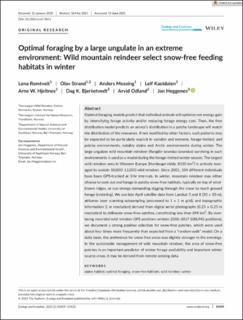| dc.contributor.author | Romtveit, Lena | |
| dc.contributor.author | Strand, Olav | |
| dc.contributor.author | Mossing, Anders | |
| dc.contributor.author | Kastdalen, Leif | |
| dc.contributor.author | Hjeltnes, Arne William | |
| dc.contributor.author | Bjerketvedt, Dag Kjartan | |
| dc.contributor.author | Odland, Arvid | |
| dc.contributor.author | Heggenes, Jan | |
| dc.date.accessioned | 2022-04-08T08:49:47Z | |
| dc.date.available | 2022-04-08T08:49:47Z | |
| dc.date.created | 2021-08-02T09:51:14Z | |
| dc.date.issued | 2021 | |
| dc.identifier.citation | Romtveit, L., Strand, O., Mossing, A., Kastdalen, L., Hjeltnes, A. W., Bjerketvedt, D. K., Odland, A. & Heggenes, J. (2021). Optimal foraging by a large ungulate in an extreme environment: Wild mountain reindeer select snow-free feeding habitats in winter. Ecology and Evolution, 11(15), 10409-10420. | en_US |
| dc.identifier.issn | 2045-7758 | |
| dc.identifier.uri | https://hdl.handle.net/11250/2990706 | |
| dc.description.abstract | Optimal foraging models predict that individual animals will optimize net energy gain by intensifying forage activity and/or reducing forage energy cost. Then, the free distribution model predicts an animal's distribution in a patchy landscape will match the distribution of the resources. If not modified by other factors, such patterns may be expected to be particularly explicit in variable and extreme, forage-limited, and patchy environments, notably alpine and Arctic environments during winter. The large ungulate wild mountain reindeer (Rangifer tarandus tarandus) surviving in such environments is used as a model during the forage-limited winter season. The largest wild reindeer area in Western Europe (Hardangervidda, 8130 km2) is actively managed to sustain 10,000–12,000 wild reindeer. Since 2001, 104 different individuals have been GPS-tracked at 3-hr intervals. In winter, mountain reindeer may either choose to seek out and forage in patchy snow-free habitats, typically on top of wind-blown ridges, or use energy-demanding digging through the snow to reach ground forage (cratering). We use late April satellite data from Landsat 5 and 8 (30 × 30 m), airborne laser scanning subsampling (processed to 1 × 1 m grid), and topographic information (1 m resolution) derived from digital aerial photographs (0.25 × 0.25 m resolution) to delineate snow-free patches, constituting less than 694 km2. By overlaying recorded wild reindeer GPS positions winters 2001–2017 (188,942 positions), we document a strong positive selection for snow-free patches, which were used about four times more frequently than expected from a “random walk” model. On a daily basis, the preference for snow-free areas was slightly stronger in the evenings. In the sustainable management of wild mountain reindeer, the area of snow-free patches is an important predictor of winter forage availability and important winter source areas. It may be derived from remote sensing data. | en_US |
| dc.language.iso | eng | en_US |
| dc.rights | Navngivelse 4.0 Internasjonal | * |
| dc.rights.uri | http://creativecommons.org/licenses/by/4.0/deed.no | * |
| dc.title | Optimal foraging by a large ungulate in an extreme environment: Wild mountain reindeer select snow-free feeding habitats in winter | en_US |
| dc.type | Journal article | en_US |
| dc.type | Peer reviewed | en_US |
| dc.description.version | publishedVersion | en_US |
| dc.rights.holder | © 2021 The Authors. | en_US |
| dc.subject.nsi | VDP::Zoologiske og botaniske fag: 480 | en_US |
| dc.subject.nsi | VDP::Zoology and botany: 480 | en_US |
| dc.source.pagenumber | 10409-10420 | en_US |
| dc.source.volume | 11 | en_US |
| dc.source.journal | Ecology and Evolution | en_US |
| dc.source.issue | 15 | en_US |
| dc.identifier.doi | https://doi.org/10.1002/ece3.7843 | |
| dc.identifier.cristin | 1923310 | |
| cristin.ispublished | true | |
| cristin.fulltext | original | |
| cristin.qualitycode | 1 | |

